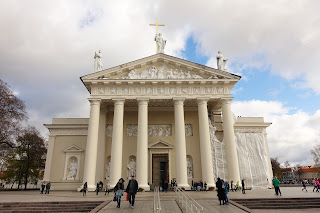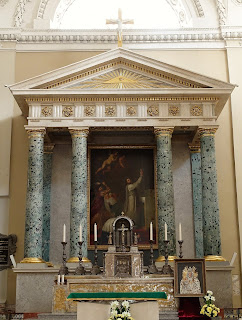My daughter stands in Cathedral Square, in front of the Vilnius Cathedral and the Cathedral Belfry
It is a national symbol of Lithuania and one of Vilnius' most popular tourist sites, but it's taken us almost six months to visit the Cathedral of St. Stanislav and St. Vladislav, better known as Vilnius Cathedral (Vilniaus Arkikatedra). But then again, when you're going to be here for another 18 months or so, there's really no hurry to see everything. The cathedral stands on a site originally used for the worship of Perkŭnas, the god of thunder in Lithuanian paganism. The first wooden cathedral was erected in 1387-88, though there may've been a church here as early as 1251. Over the centuries the cathedral was destroyed and reconstructed several times, until finally taking its present classical form (and following its original Gothic floor plan) in the late 18th century. Soviet occupiers closed the church in 1950 and considered converting it into a garage for the repair of trucks, before opening it as as a warehouse, art gallery and concert venue, beginning in 1956. It was returned to the Catholic Church and reconsecrated in 1989. Despite appearances to the contrary in the photo below, the Cathedral Belfry does not tilt ala the Leaning Tower of Pisa; that's just my camera trying to squeeze as much as it can into the frame:
The entrance to the cathedral is by way of a large Classical portico:
Stucco sculptures on the facade above the entrance depict a bird being sacrificed:
A statue of the evangelist Luke with a bull flanks the front door on the southern side of the church:
A look back at the belfry before going inside the cathedral. We bought our tickets for the crypt at the counter inside the belfry, but didn't go up the stairs to the top of the tower. This is something we're saving for another (clearer) day:
The interior of Vilnius Cathedral is suitably impressive, though by this point we've seen a lot of houses of worship and it's becoming difficult to distinguish one from another. A mural from inside the early 17th-century Valavičius Chapel, dedicated to a family of local governors and bishops:
There are two highlights of a visit to the Vilnius Cathedral. One is the baroque cupola, colored marble and frescoes and magnificent stucco figures of St. Casimir's Chapel, a Baroque beauty created by Italian artisans from 1623-1636. The chapel is dedicated to a prince of the Kingdom of Poland and Grand Duchy of Lithuania, who shunned the luxuries of royal life to devote himself to a life of prayer, before dying of tuberculosis at the age of 25. What I didn't realize at the time (thanks to my guidebooks not mentioning it) is that the saint is depicted on the altar in the chapel as having two right hands (in addition to the standard single left one):
The High Altar of the cathedral was fashioned from gold and silver in the 1620's. The panel depicts the Last Supper and Christ Washing the Disciples' Feet:
The other highlight of a visit to Vilnius Cathedral is the (mandatory) guided tour of the crypts, the resting place of many prominent Lithuanians, including the remains of two Grand Dukes and two wives of Sigismund II Augustus, the last descendant of national icon Gediminas:
The most prominent resident of the crypt is (was?) Vytautas the Great. This sarcophagus was created in the period between the two World Wars, during a time when the newly-independent Lithuania was looking for national heroes. It was made to keep the bones of Vytautas, but remains empty as his remains have remained (puns intended) elusive:
There are coffins that are still occupied, like these ones belonging to latter-day bishops:
One of the oldest surviving frescoes in Lithuania dates from the 14th century and was discovered in the crypts in 1925. Amber poses next to a reproduction...:
...while the original can be glimpsed through a door panel, reflected in a mirror:
My wife and daughter whisper to each other, taking advantage of an acoustic quirk of the vaulted ceiling in the crypt:
Leaving the cathedral and facing Gediminas Prospektas:
It had rained while the three of us were inside touring the crypt. A rainbow was waiting to greet us as we returned to the outside world:
The oft-photographed (and suitably creepy for Halloween) Three Muses statue, posing for the tourists atop the Lithuanian National Drama Theater on Gedimino prospektas:
Though we are unapologetic carnivores, Amber, Shu-E and I do like to go vegan every once in a while. Dinner on Saturday evening was at Vegcafe, where I enjoyed a dinner of bhaji and rice, washed down with a minty lemonade:

























No comments:
Post a Comment